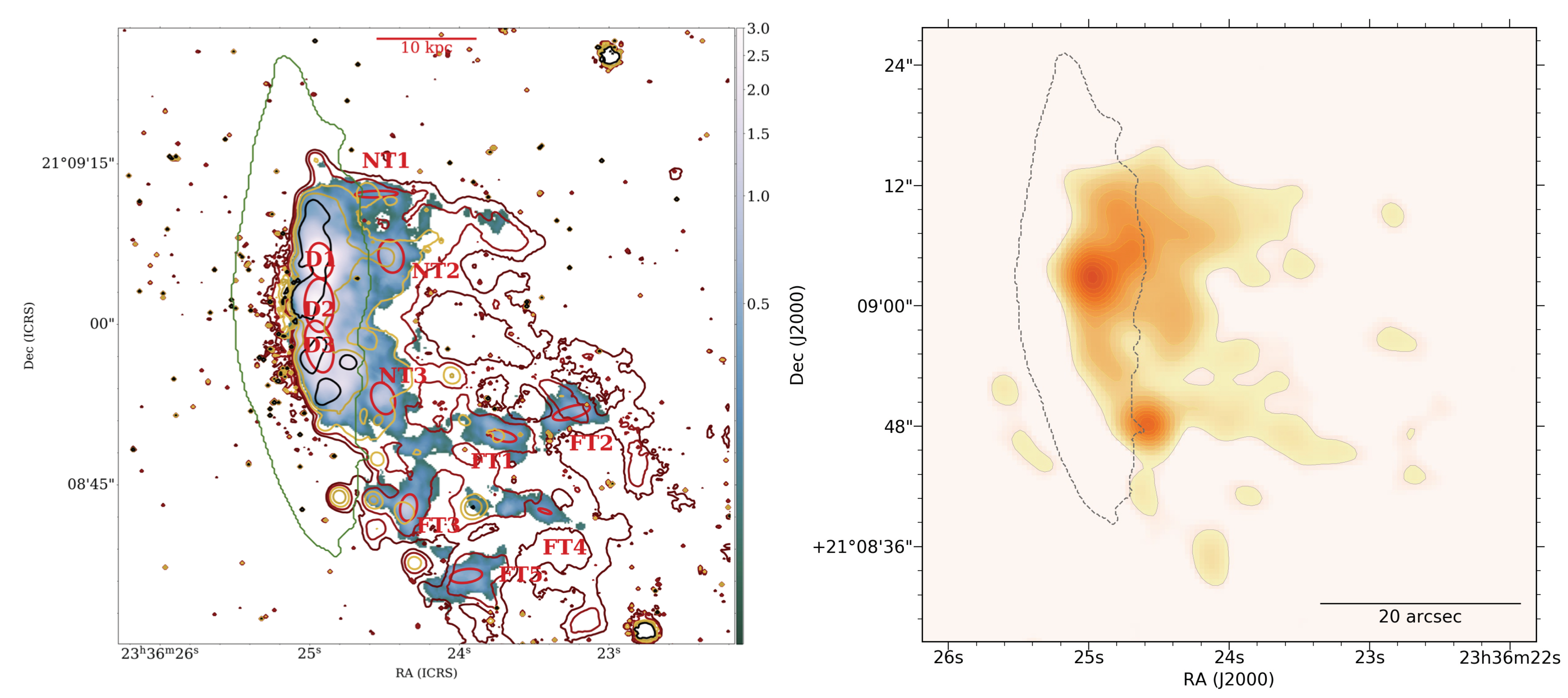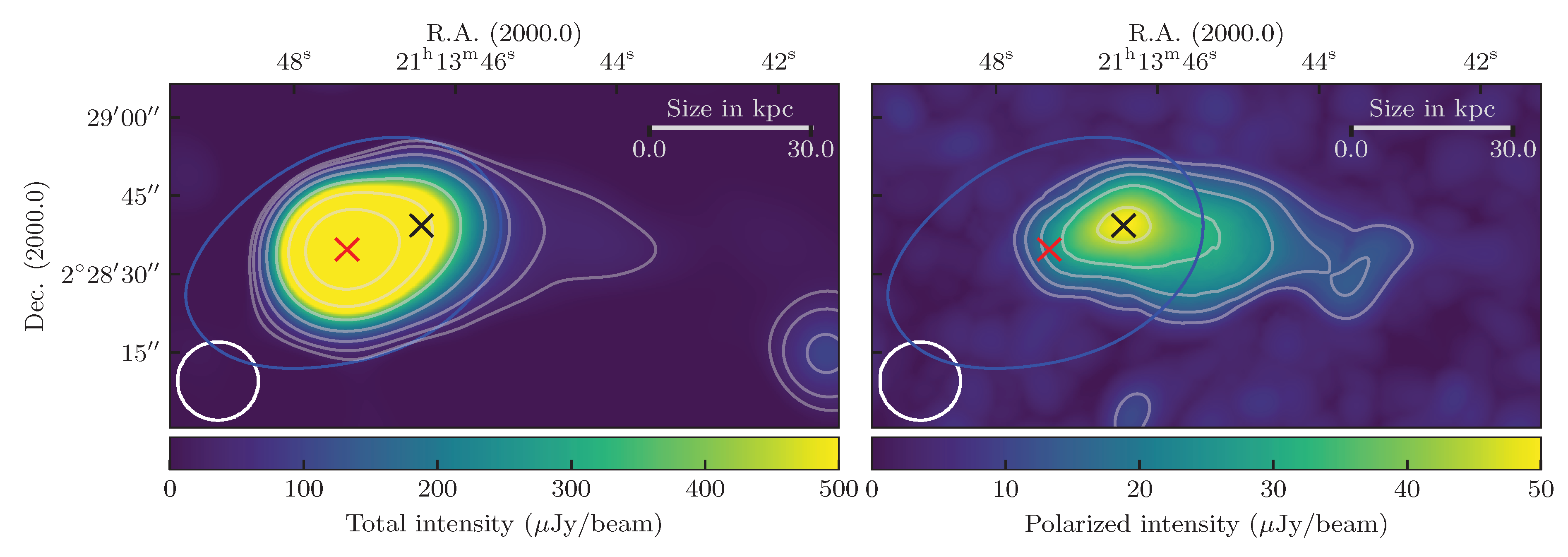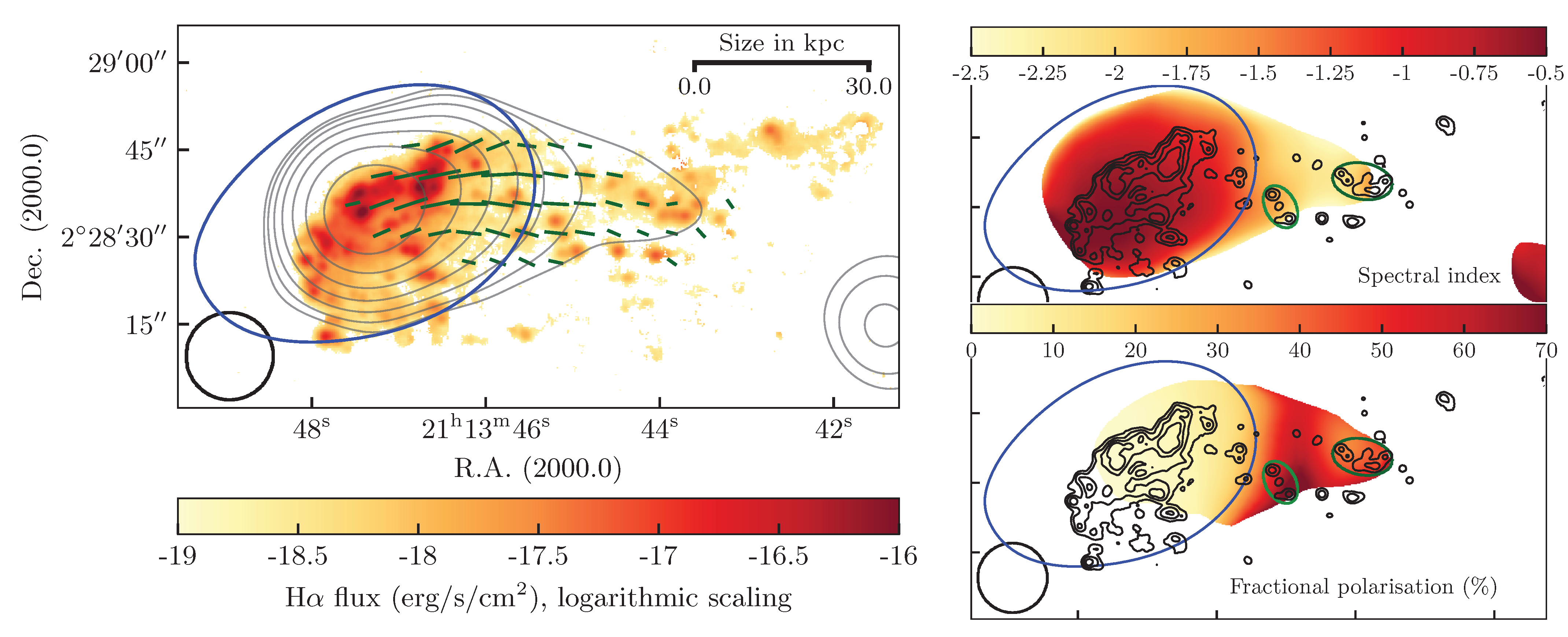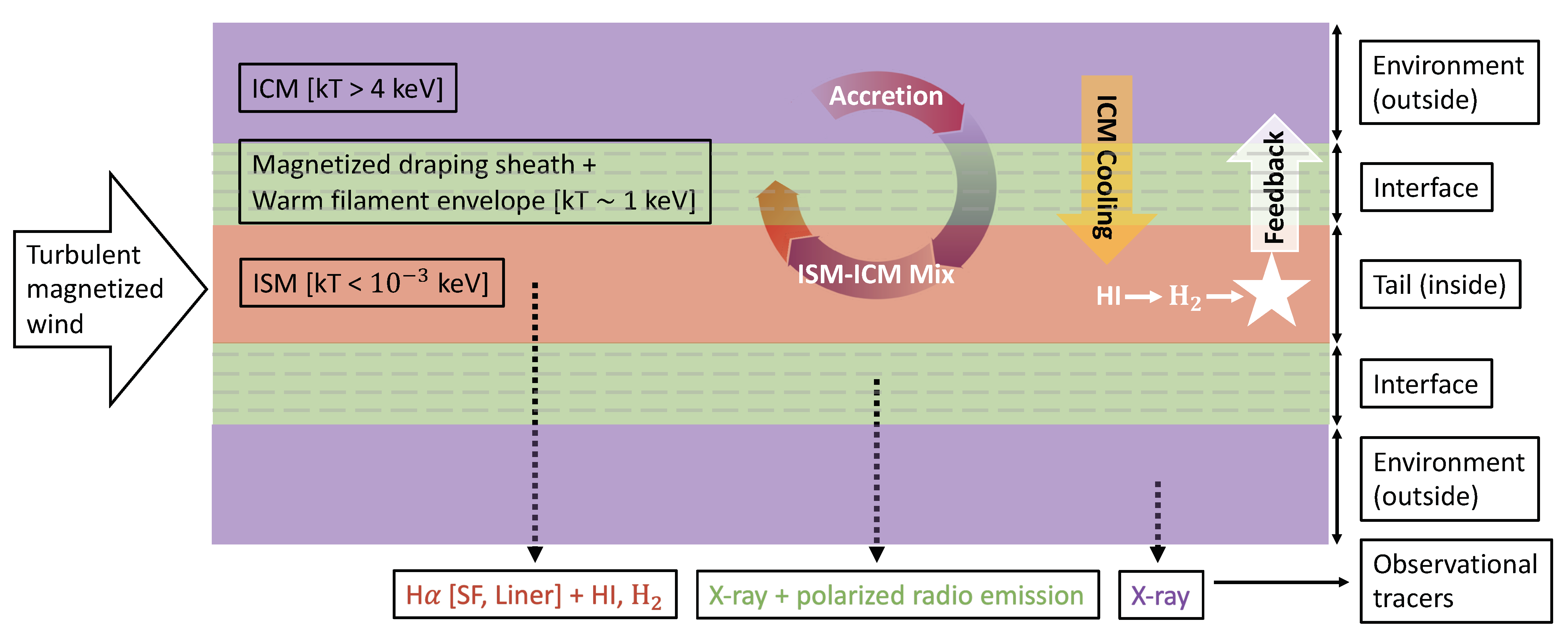Role of Magnetic Fields in Ram Pressure Stripped Galaxies
Abstract
1. Introduction
2. The GASP Survey
3. Multi-Phase Gas
4. Radio Continuum and Polarization Observations
5. Theoretical View
6. Holistic Picture
7. Current Limitation and Future Perspective
8. Conclusions
Author Contributions
Funding
Data Availability Statement
Acknowledgments
Conflicts of Interest
| 1 | https://web.oapd.inaf.it/gasp/ accessed on 9 December 2021) |
| 2 | For more details and information on the collection of publications, see https://web.oapd.inaf.it/gasp/ (accessed on 9 December 2021) |
| 3 |
References
- Noeske, K.G.; Weiner, B.J.; Faber, S.M.; Papovich, C.; Koo, D.C.; Somerville, R.S.; Bundy, K.; Conselice, C.J.; Newman, J.A.; Schiminovich, D.; et al. Star Formation in AEGIS Field Galaxies since z = 1.1: The Dominance of Gradually Declining Star Formation, and the Main Sequence of Star-forming Galaxies. Astrophys. J. 2007, 660, L43–L46. [Google Scholar] [CrossRef]
- Madau, P.; Dickinson, M. Cosmic Star-Formation History. Annu. Rev. Astron. Astrophys. 2014, 52, 415–486. [Google Scholar] [CrossRef]
- Boselli, A.; Gavazzi, G. Environmental Effects on Late-Type Galaxies in Nearby Clusters. Publ. Astron. Soc. Pac. 2006, 118, 517–559. [Google Scholar] [CrossRef]
- Cayatte, V.; van Gorkom, J.H.; Balkowski, C.; Kotanyi, C. VLA Observations of Neutral Hydrogen in Virgo Cluster Galaxies. I. The Atlas. Astron. J. 1990, 100, 604. [Google Scholar] [CrossRef]
- Kenney, J.D.P.; van Gorkom, J.H.; Vollmer, B. VLA HiObservations of Gas Stripping in the Virgo Cluster Spiral NGC 4522. Astron. J. 2004, 127, 3361–3374. [Google Scholar] [CrossRef]
- Chung, A.; van Gorkom, J.H.; Kenney, J.D.P.; Crowl, H.; Vollmer, B. VLA Imaging of Virgo Spirals in Atomic Gas (VIVA). I. The Atlas and the H I Properties. Astrophys. J. 2009, 138, 1741–1816. [Google Scholar] [CrossRef]
- Jaffé, Y.L.; Smith, R.; Candlish, G.N.; Poggianti, B.M.; Sheen, Y.K.; Verheijen, M.A.W. BUDHIES II: A phase-space view of H I gas stripping and star formation quenching in cluster galaxies. Mon. Not. R. Astron. Soc. 2015, 448, 1715–1728. [Google Scholar] [CrossRef]
- Scott, T.C.; Brinks, E.; Cortese, L.; Boselli, A.; Bravo-Alfaro, H. Abell 1367: A high fraction of late-type galaxies displaying H I morphological and kinematic perturbations. Mon. Not. R. Astron. Soc. 2018, 475, 4648–4669. [Google Scholar] [CrossRef]
- Williams, B.A.; Rood, H.J. Neutral Hydrogen in Compact Groups of Galaxies. Astrophys. J. 1987, 63, 265. [Google Scholar] [CrossRef]
- Verdes-Montenegro, L.; Yun, M.S.; Williams, B.A.; Huchtmeier, W.K.; Del Olmo, A.; Perea, J. Where is the neutral atomic gas in Hickson groups? Astron. Astrophys. 2001, 377, 812–826. [Google Scholar] [CrossRef]
- Serra, P.; Koribalski, B.; Duc, P.A.; Oosterloo, T.; McDermid, R.M.; Michel-Dansac, L.; Emsellem, E.; Cuillandre, J.C.; Alatalo, K.; Blitz, L.; et al. Discovery of a giant HI tail in the galaxy group HCG 44. Mon. Not. R. Astron. Soc. 2013, 428, 370–380. [Google Scholar] [CrossRef]
- Bellhouse, C.; Jaffé, Y.L.; Hau, G.K.T.; McGee, S.L.; Poggianti, B.M.; Moretti, A.; Gullieuszik, M.; Bettoni, D.; Fasano, G.; D’Onofrio, M.; et al. GASP. II. A MUSE View of Extreme Ram-Pressure Stripping along the Line of Sight: Kinematics of the Jellyfish Galaxy JO201. Astrophys. J. 2017, 844, 49. [Google Scholar] [CrossRef]
- Boselli, A.; Fossati, M.; Sun, M. Ram Pressure Stripping in High-Density Environments. arXiv 2021, arXiv:2109.13614. [Google Scholar]
- Cortese, L.; Marcillac, D.; Richard, J.; Bravo-Alfaro, H.; Kneib, J.P.; Rieke, G.; Covone, G.; Egami, E.; Rigby, J.; Czoske, O.; et al. The strong transformation of spiral galaxies infalling into massive clusters at z ~ 0.2. Mon. Not. R. Astron. Soc. 2007, 376, 157–172. [Google Scholar] [CrossRef]
- Poggianti, B.M.; Gullieuszik, M.; Tonnesen, S.; Moretti, A.; Vulcani, B.; Radovich, M.; Jaffé, Y.; Fritz, J.; Bettoni, D.; Franchetto, A.; et al. GASP XIII. Star formation in gas outside galaxies. Mon. Not. R. Astron. Soc. 2019, 482, 4466–4502. [Google Scholar] [CrossRef]
- Crutcher, R.M. Magnetic Fields in Molecular Clouds. Annu. Rev. Astron. Astrophys. 2012, 50, 29–63. [Google Scholar] [CrossRef]
- Heesen, V.; Beck, R.; Krause, M.; Dettmar, R.J. Cosmic rays and the magnetic field in the nearby starburst galaxy NGC 253 III. Helical magnetic fields in the nuclear outflow. Astron. Astrophys. 2011, 535, A79. [Google Scholar] [CrossRef]
- Beck, R.; Wielebinski, R. Magnetic Fields in Galaxies. In Planets, Stars and Stellar Systems. Volume 5: Galactic Structure and Stellar Populations; Springer: Berlin/Heidelberg, Germany, 2013; Volume 5, p. 641. [Google Scholar] [CrossRef]
- Li, H.B.; Henning, T. The alignment of molecular cloud magnetic fields with the spiral arms in M33. Nature 2011, 479, 499–501. [Google Scholar] [CrossRef]
- Gavazzi, G.; Contursi, A.; Carrasco, L.; Boselli, A.; Kennicutt, R.; Scodeggio, M.; Jaffe, W. The radio and optical structure of three peculiar galaxies in A 1367. Astron. Astrophys. 1995, 304, 325. [Google Scholar]
- Vollmer, B.; Soida, M.; Chung, A.; Beck, R.; Urbanik, M.; Chyży, K.T.; Otmianowska-Mazur, K.; van Gorkom, J.H. The influence of the cluster environment on the large-scale radio continuum emission of 8 Virgo cluster spirals. Astron. Astrophys. 2010, 512, A36. [Google Scholar] [CrossRef]
- Chen, H.; Sun, M.; Yagi, M.; Bravo-Alfaro, H.; Brinks, E.; Kenney, J.; Combes, F.; Sivanandam, S.; Jachym, P.; Fossati, M.; et al. The ram pressure stripped radio tails of galaxies in the Coma cluster. Mon. Not. R. Astron. Soc. 2020, 496, 4654–4673. [Google Scholar] [CrossRef]
- Müller, A.; Poggianti, B.M.; Pfrommer, C.; Adebahr, B.; Serra, P.; Ignesti, A.; Sparre, M.; Gitti, M.; Dettmar, R.J.; Vulcani, B.; et al. Highly ordered magnetic fields in the tail of the jellyfish galaxy JO206. Nat. Astron. 2021, 5, 159–168. [Google Scholar] [CrossRef]
- Ignesti, A.; Vulcani, B.; Poggianti, B.M.; Paladino, R.; Shimwell, T.; Healy, J.; Gitti, M.; Bacchini, C.; Moretti, A.; Radovich, M.; et al. GASP XXXVIII: The LOFAR-MeerKAT-VLA view on the non-thermal side of a jellyfish galaxy. arXiv 2021, arXiv:2110.12719. [Google Scholar]
- Poggianti, B.M.; Ignesti, A.; Gitti, M.; Wolter, A.; Brighenti, F.; Biviano, A.; George, K.; Vulcani, B.; Gullieuszik, M.; Moretti, A.; et al. GASP XXIII: A Jellyfish Galaxy as an Astrophysical Laboratory of the Baryonic Cycle. Astrophys. J. 2019, 887, 155. [Google Scholar] [CrossRef]
- Shimwell, T.W.; Röttgering, H.J.A.; Best, P.N.; Williams, W.L.; Dijkema, T.J.; de Gasperin, F.; Hardcastle, M.J.; Heald, G.H.; Hoang, D.N.; Horneffer, A.; et al. The LOFAR Two-metre Sky Survey. I. Survey description and preliminary data release. Astron. Astrophys. 2017, 598, A104. [Google Scholar] [CrossRef]
- Roberts, I.D.; van Weeren, R.J.; McGee, S.L.; Botteon, A.; Drabent, A.; Ignesti, A.; Rottgering, H.J.A.; Shimwell, T.W.; Tasse, C. LoTSS jellyfish galaxies. Astron. Astrophys. 2021, 650, A111. [Google Scholar] [CrossRef]
- Roberts, I.D.; van Weeren, R.J.; McGee, S.L.; Botteon, A.; Ignesti, A.; Rottgering, H.J.A. LoTSS jellyfish galaxies: II. Ram pressure stripping in groups versus clusters. arXiv 2021, arXiv:2106.06315. [Google Scholar] [CrossRef]
- Poggianti, B.M.; Moretti, A.; Gullieuszik, M.; Fritz, J.; Jaffé, Y.; Bettoni, D.; Fasano, G.; Bellhouse, C.; Hau, G.; Vulcani, B.; et al. GASP. I. Gas Stripping Phenomena in Galaxies with MUSE. Astrophys. J. 2017, 844, 48. [Google Scholar] [CrossRef]
- Poggianti, B.M.; Fasano, G.; Omizzolo, A.; Gullieuszik, M.; Bettoni, D.; Moretti, A.; Paccagnella, A.; Jaffé, Y.L.; Vulcani, B.; Fritz, J.; et al. Jellyfish Galaxy Candidates at Low Redshift. Astron. J. 2016, 151, 78. [Google Scholar] [CrossRef]
- Ramatsoku, M.; Serra, P.; Poggianti, B.M.; Moretti, A.; Gullieuszik, M.; Bettoni, D.; Deb, T.; Fritz, J.; van Gorkom, J.H.; Jaffe, Y.L.; et al. GASP–XVII. H I imaging of the jellyfish galaxy JO206: Gas stripping and enhanced star formation. Mon. Not. R. Astron. Soc. 2019, 487, 4580–4591. [Google Scholar] [CrossRef]
- Ramatsoku, M.; Serra, P.; Poggianti, B.M.; Moretti, A.; Gullieuszik, M.; Bettoni, D.; Deb, T.; Franchetto, A.; van Gorkom, J.H.; Jaffé, Y.; et al. GASP. XXVI. HI gas in jellyfish galaxies: The case of JO201 and JO206. Astron. Astrophys. 2020, 640, A22. [Google Scholar] [CrossRef]
- Deb, T.; Verheijen, M.A.W.; Gullieuszik, M.; Poggianti, B.M.; van Gorkom, J.H.; Ramatsoku, M.; Serra, P.; Moretti, A.; Vulcani, B.; Bettoni, D.; et al. GASP XXV: Neutral hydrogen gas in the striking jellyfish galaxy JO204. Mon. Not. R. Astron. Soc. 2020, 494, 5029–5043. [Google Scholar] [CrossRef]
- Moretti, A.; Paladino, R.; Poggianti, B.M.; D’Onofrio, M.; Bettoni, D.; Gullieuszik, M.; Jaffé, Y.L.; Vulcani, B.; Fasano, G.; Fritz, J.; et al. GASP-X. APEX observations of molecular gas in the discs and in the tails of ram-pressure stripped galaxies. Mon. Not. R. Astron. Soc. 2018, 480, 2508–2520. [Google Scholar] [CrossRef]
- Moretti, A.; Paladino, R.; Poggianti, B.M.; Serra, P.; Ramatsoku, M.; Franchetto, A.; Deb, T.; Gullieuszik, M.; Tomičić, N.; Mingozzi, M.; et al. The High Molecular Gas Content, and the Efficient Conversion of Neutral into Molecular Gas, in Jellyfish Galaxies. Astrophys. J. 2020, 897, L30. [Google Scholar] [CrossRef]
- Campitiello, M.G.; Ignesti, A.; Gitti, M.; Brighenti, F.; Radovich, M.; Wolter, A.; Tomičić, N.; Bellhouse, C.; Poggianti, B.M.; Moretti, A.; et al. GASP XXXIV: Unfolding the Thermal Side of Ram Pressure Stripping in the Jellyfish Galaxy JO201. Astrophys. J. 2021, 911, 144. [Google Scholar] [CrossRef]
- Tomicic, N.; Vulcani, B.; Poggianti, B.M.; Werle, A.; Muller, A.; Mingozzi, M.; Gullieuszik, M.; Wolter, A.; Radovich, M.; Moretti, A.; et al. GASP XXXV: Characteristics of the diffuse ionised gas in gas-stripped galaxies. arXiv 2021, arXiv:2108.12433. [Google Scholar]
- Sun, M.; Ge, C.; Luo, R.; Yagi, M.; Jáchym, P.; Boselli, A.; Fossati, M.; Nulsen, P.E.J.; Yoshida, M.; Gavazzi, G. Tales of tails: Hα–X-ray correlation. arXiv 2021, arXiv:2103.09205. [Google Scholar]
- Jaffé, Y.L.; Poggianti, B.M.; Moretti, A.; Gullieuszik, M.; Smith, R.; Vulcani, B.; Fasano, G.; Fritz, J.; Tonnesen, S.; Bettoni, D.; et al. GASP. IX. Jellyfish galaxies in phase-space: An orbital study of intense ram-pressure stripping in clusters. Mon. Not. R. Astron. Soc. 2018, 476, 4753–4764. [Google Scholar] [CrossRef]
- Ignesti, A.; Gitti, M.; Brunetti, G.; O’Sullivan, E.; Sarazin, C.; Wong, K. The mystery of the “Kite” radio source in Abell 2626: Insights from new Chandra observations. Astron. Astrophys. 2018, 610, A89. [Google Scholar] [CrossRef]
- Strickland, D.K.; Heckman, T.M.; Colbert, E.J.M.; Hoopes, C.G.; Weaver, K.A. A High Spatial Resolution X-ray and Hα Study of Hot Gas in the Halos of Star-forming Disk Galaxies. I. Spatial and Spectral Properties of the Diffuse X-ray Emission. Astrophys. J. 2004, 151, 193–236. [Google Scholar] [CrossRef]
- Moretti, A.; Paladino, R.; Poggianti, B.M.; Serra, P.; Roediger, E.; Gullieuszik, M.; Tomičić, N.; Radovich, M.; Vulcani, B.; Jaffé, Y.L.; et al. GASP. XXII. The Molecular Gas Content of the JW100 Jellyfish Galaxy at z ∼ 0.05: Does Ram Pressure Promote Molecular Gas Formation? Astrophys. J. 2020, 889, 9. [Google Scholar] [CrossRef]
- Müller, A.; Pfrommer, C.; Ignesti, A.; Moretti, A.; Lourenço, A.; Paladino, R.; Jaffé, Y.; Gitti, M.; Venturi, T.; Gullieuszik, M.; et al. Two striking head-tail galaxies in the galaxy cluster IIZW108: Insights into transition to turbulence, magnetic fields, and particle re-acceleration. Mon. Not. R. Astron. Soc. 2021, 508, 5326–5344. [Google Scholar] [CrossRef]
- Gitti, M. The puzzling radio source in the cool core cluster A2626. Mon. Not. R. Astron. Soc. 2013, 436, L84–L88. [Google Scholar] [CrossRef]
- Ignesti, A.; Gitti, M.; Brunetti, G.; Feretti, L.; Giovannini, G. New JVLA observations at 3 GHz and 5.5 GHz of the “Kite” radio source in Abell 2626. Astron. Astrophys. 2017, 604, A21. [Google Scholar] [CrossRef]
- Ignesti, A.; Shimwell, T.; Brunetti, G.; Gitti, M.; Intema, H.; van Weeren, R.J.; Hardcastle, M.J.; Clarke, A.O.; Botteon, A.; Di Gennaro, G.; et al. The great Kite in the sky: A LOFAR observation of the radio source in Abell 2626. Astron. Astrophys. 2020, 643, A172. [Google Scholar] [CrossRef]
- Tonnesen, S.; Stone, J. The Ties that Bind? Galactic Magnetic Fields and Ram Pressure Stripping. Astrophys. J. 2014, 795, 148. [Google Scholar] [CrossRef]
- Ramos-Martínez, M.; Gómez, G.C.; Pérez-Villegas, Á. MHD simulations of ram pressure stripping of a disc galaxy. Mon. Not. R. Astron. Soc. 2018, 476, 3781–3792. [Google Scholar] [CrossRef]
- Vollmer, B.; Soida, M.; Beck, R.; Urbanik, M.; Chyży, K.T.; Otmianowska-Mazur, K.; Kenney, J.D.P.; van Gorkom, J.H. The characteristic polarized radio continuum distribution of cluster spiral galaxies. Astron. Astrophys. 2007, 464, L37–L40. [Google Scholar] [CrossRef][Green Version]
- Dursi, L.J.; Pfrommer, C. Draping of Cluster Magnetic Fields over Bullets and Bubbles—Morphology and Dynamic Effects. Astrophys. J. 2008, 677, 993–1018. [Google Scholar] [CrossRef]
- Pfrommer, C.; Dursi, L.J. Detecting the orientation of magnetic fields in galaxy clusters. Nat. Phys. 2010, 6, 520–526. [Google Scholar] [CrossRef]
- Ruszkowski, M.; Brüggen, M.; Lee, D.; Shin, M.S. Impact of Magnetic Fields on Ram Pressure Stripping in Disk Galaxies. Astrophys. J. 2014, 784, 75. [Google Scholar] [CrossRef]
- Berlok, T.; Pfrommer, C. The impact of magnetic fields on cold streams feeding galaxies. Mon. Not. R. Astron. Soc. 2019, 489, 3368–3384. [Google Scholar] [CrossRef]
- Springel, V. Moving-mesh hydrodynamics with the AREPO code. Proc. Int. Astron. Union 2010, 6, 203–206. [Google Scholar] [CrossRef]
- Pakmor, R.; Springel, V. Simulations of magnetic fields in isolated disc galaxies. Mon. Not. R. Astron. Soc. 2013, 432, 176–193. [Google Scholar] [CrossRef]
- Pakmor, R.; Springel, V.; Bauer, A.; Mocz, P.; Munoz, D.J.; Ohlmann, S.T.; Schaal, K.; Zhu, C. Improving the convergence properties of the moving-mesh code AREPO. Mon. Not. R. Astron. Soc. 2015, 455, 1134–1143. [Google Scholar] [CrossRef]
- Sparre, M.; Pfrommer, C.; Ehlert, K. Interaction of a cold cloud with a hot wind: The regimes of cloud growth and destruction and the impact of magnetic fields. arXiv 2020, arXiv:2008.09118. [Google Scholar] [CrossRef]
- Gronke, M.; Oh, S.P. The growth and entrainment of cold gas in a hot wind. Mon. Not. R. Astron. Soc. 2018, 480, L111–L115. [Google Scholar] [CrossRef]
- Li, Z.; Hopkins, P.F.; Squire, J.; Hummels, C. On the survival of cool clouds in the circumgalactic medium. Mon. Not. R. Astron. Soc. 2020, 492, 1841–1854. [Google Scholar] [CrossRef]
- McDonald, M.; Veilleux, S.; Rupke, D.S.N. Optical Spectroscopy of Halpha Filaments in Cool Core Clusters: Kinematics, Reddening, and Sources Of Ionization. Astrophys. J. 2012, 746, 153. [Google Scholar] [CrossRef]
- Olivares, V.; Salome, P.; Combes, F.; Hamer, S.; Guillard, P.; Lehnert, M.D.; Polles, F.L.; Beckmann, R.S.; Dubois, Y.; Donahue, M.; et al. Ubiquitous cold and massive filaments in cool core clusters. Astron. Astrophys. 2019, 631, A22. [Google Scholar] [CrossRef]
- Morabito, L.K.; Jackson, N.J.; Mooney, S.; Sweijen, F.; Badole, S.; Kukreti, P.; Venkattu, D.; Groeneveld, C.; Kappes, A.; Bonnassieux, E.; et al. Sub-arcsecond imaging with the International LOFAR Telescope I. Foundational calibration strategy and pipeline. arXiv 2021, arXiv:2108.07283. [Google Scholar] [CrossRef]






Publisher’s Note: MDPI stays neutral with regard to jurisdictional claims in published maps and institutional affiliations. |
© 2021 by the authors. Licensee MDPI, Basel, Switzerland. This article is an open access article distributed under the terms and conditions of the Creative Commons Attribution (CC BY) license (https://creativecommons.org/licenses/by/4.0/).
Share and Cite
Müller, A.; Ignesti, A.; Poggianti, B.; Moretti, A.; Ramatsoku, M.; Dettmar, R.-J. Role of Magnetic Fields in Ram Pressure Stripped Galaxies. Galaxies 2021, 9, 116. https://doi.org/10.3390/galaxies9040116
Müller A, Ignesti A, Poggianti B, Moretti A, Ramatsoku M, Dettmar R-J. Role of Magnetic Fields in Ram Pressure Stripped Galaxies. Galaxies. 2021; 9(4):116. https://doi.org/10.3390/galaxies9040116
Chicago/Turabian StyleMüller, Ancla, Alessandro Ignesti, Bianca Poggianti, Alessia Moretti, Mpati Ramatsoku, and Ralf-Jürgen Dettmar. 2021. "Role of Magnetic Fields in Ram Pressure Stripped Galaxies" Galaxies 9, no. 4: 116. https://doi.org/10.3390/galaxies9040116
APA StyleMüller, A., Ignesti, A., Poggianti, B., Moretti, A., Ramatsoku, M., & Dettmar, R.-J. (2021). Role of Magnetic Fields in Ram Pressure Stripped Galaxies. Galaxies, 9(4), 116. https://doi.org/10.3390/galaxies9040116





